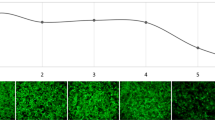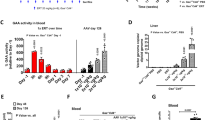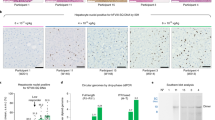Abstract
Previous work from our group showed that recombinant adeno-associated virus (rAAV) vectors mediated long-term secretion of therapeutic serum levels of human alpha-1 antitrypsin (hAAT) after a single injection in murine muscle. We hypothesized that hepatocyte transduction could be even more efficient, since these cells represent the natural site of AAT production and secretion. To test this hypothesis, rAAV vectors containing the hAAT cDNA driven by either the human elongation factor 1 alpha promoter, the human cytomegalovirus immediate–early promoter (CMV), or the CMV-chicken beta actin hybrid (CB) promoter were injected into the portal or tail veins of adult C57Bl/6 mice. Potentially therapeutic serum levels of hAAT (600 μg/ml) were achieved after portal vein injection of doses of 4 × 109 infectious units (IU), a 10-fold lower dose than that required for similar levels of expression via the i.m. route. Serum levels greater than 1 mg/ml were achieved at doses of 3 × 1010 IU. Southern blotting of liver DNA revealed the presence of circular episomal vector genomes. Immunostaining showed that transgene expression was scattered throughout the liver parenchyma. Similar results were obtained with a rAAV-CB-green fluorescent protein (GFP) vector. There was no evidence of hepatic toxicity. These data indicate that liver-directed rAAV-based gene therapy is effective in the murine model, and hence might be feasible for treatment of human AAT deficiency.
This is a preview of subscription content, access via your institution
Access options
Subscribe to this journal
Receive 12 print issues and online access
$259.00 per year
only $21.58 per issue
Buy this article
- Purchase on Springer Link
- Instant access to full article PDF
Prices may be subject to local taxes which are calculated during checkout






Similar content being viewed by others
References
Crystal RG . The alpha 1-antitrypsin gene and its deficiency states Trends Genet 1989 5: 411–417
Brantly ML et al. Use of a highly purified alpha 1-antitrypsin standard to establish ranges for the common normal and deficient alpha 1-antitrypsin phenotypes Chest 1991 100: 703–708
Sharp HL, Bridges RA, Krivit W, Freier EF . Cirrhosis associated with alpha-1-antitrypsin deficiency: a previously unrecognized inherited disorder J Lab Clin Med 1969 73: 934–939
Lomas DA, Evans DL, Finch JT, Carrell RW . The mechanism of Z alpha 1-antitrypsin accumulation in the liver (see comments) Nature 1992 357: 605–607
Lomas DA . Loop-sheet polymerization: the mechanism of alpha1-antitrypsin deficiency Respir Med 2000 94: (Suppl. C) S3–6
Wewers MD, Casolaro MA, Crystal RG . Comparison of alpha-1-antitrypsin levels and antineutrophil elastase capacity of blood and lung in a patient with the alpha-1-antitrypsin phenotype null-null before and during alpha-1-antitrypsin augmentation therapy Am Rev Respir Dis 1987 135: 539–543
Garver RI Jr, Chytil A, Courtney M, Crystal RG . Clonal gene therapy: transplanted mouse fibroblast clones express human alpha 1-antitrypsin gene in vivo Science 1987 237: 762–764
Rosenfeld MA et al. Adenovirus-mediated transfer of a recombinant alpha 1-antitrypsin gene to the lung epithelium in vivo (see comments) Science 1991 252: 431–434
Kay MA et al. Expression of human alpha 1-antitrypsin in dogs after autologous transplantation of retroviral transduced hepatocytes Proc Natl Acad Sci USA 1992 89: 89–93
Setoguchi Y, Jaffe HA, Chu CS, Crystal RG . Intraperitoneal in vivo gene therapy to deliver alpha 1-antitrypsin to the systemic circulation Am J Respir Cell Mol Biol 1994 10: 369–377
Levy MY, Barron LG, Meyer KB, Szoka FC Jr . Characterization of plasmid DNA transfer into mouse skeletal muscle: evaluation of uptake mechanism, expression and secretion of gene products into blood Gene Therapy 1996 3: 201–211
Kay MA, Graham F, Leland F, Woo SL . Therapeutic serum concentrations of human alpha-1-antitrypsin after adenoviral-mediated gene transfer into mouse hepatocytes Hepatology 1995 21: 815–819
Schiedner G et al. Genomic DNA transfer with a high-capacity adenovirus vector results in improved in vivo gene expression and decreased toxicity (published erratum appears in Nat Genet 1998 Mar; 18(3): 298) Nat Genet 1998 18: 180–183
Morral N et al. High doses of a helper-dependent adenoviral vector yield supraphysiological levels of alpha1-antitrypsin with negligible toxicity Hum Gene Ther 1998 9: 2709–2716
Song S et al. Sustained secretion of human alpha-1-antitrypsin from murine muscle transduced with adeno-associated virus vectors Proc Natl Acad Sci USA 1998 95: 14384–14388
Nakai H, Iwaki Y, Kay MA, Couto LB . Isolation of recombinant adeno-associated virus vector–cellular DNA junctions from mouse liver J Virol 1999 73: 5438–5447
Snyder RO et al. Persistent and therapeutic concentrations of human factor IX in mice after hepatic gene transfer of recombinant AAV vectors Nat Genet 1997 16: 270–276
Herzog RW et al. Stable gene transfer and expression of human blood coagulation factor IX after intramuscular injection of recombinant adeno-associated virus Proc Natl Acad Sci USA 1997 94: 5804–5809
Xiao W et al. Adeno-associated virus as a vector for liver-directed gene therapy J Virol 1998 72: 10222–10226
Miao CH et al. The kinetics of rAAV integration in the liver (letter) Nat Genet 1998 19: 13–15
Wagner JA et al. Safety and biological efficacy of an adeno-associated virus vector-cystic fibrosis transmembrane regulator (AAV-CFTR) in the cystic fibrosis maxillary sinus Laryngoscope 1999 109: 266–274
Wagner JA et al. Efficient and persistent gene transfer of AAV-CFTR in maxillary sinus (letter) Lancet 1998 351: 1702–1703
Kay MA et al. Evidence for gene transfer and expression of factor IX in haemophilia B patients treated with an AAV vector (see comments) Nat Genet 2000 24: 257–261
Miao CH et al. Nonrandom transduction of recombinant adeno-associated virus vectors in mouse hepatocytes in vivo: cell cycling does not influence hepatocyte transduction J Virol 2000 74: 3793–3803
Nakai H et al. Adeno-associated viral vector-mediated gene transfer of human blood coagulation factor IX into mouse liver Blood 1998 91: 4600–4607
Guo ZS, Wang LH, Eisensmith RC, Woo SL . Evaluation of promoter strength for hepatic gene expression in vivo following adenovirus-mediated gene transfer Gene Therapy 1996 3: 802–810
Virella-Lowell I et al. A cmv/beta actin hybrid promoter improves rAAV vector expression in vitro and in vivo. American Thoracic Society: International Conference, Toronto, ON, Canada 2000 p A286
Monahan PE et al. Direct intramuscular injection with recombinant AAV vectors results in sustained expression in a dog model of hemophilia Gene Therapy 1998 5: 40–49
Jooss K, Yang Y, Fisher KJ, Wilson JM . Transduction of dendritic cells by DNA viral vectors directs the immune response to transgene products in muscle fibers J Virol 1998 72: 4212–4223
Wakabayashi-Ito N, Nagata S . Characterization of the regulatory elements in the promoter of the human elongation factor-1 alpha gene J Biol Chem 1994 269: 29831–29837
Zolotukhin S et al. Recombinant adeno-associated virus purification using novel methods improves infectious titer and yield Gene Therapy 1999 6: 973–985
Church GM, Gilbert W . Genomic sequencing Proc Natl Acad Sci USA 1984 81: 1991–1995
Brass CA, Crawford JM, Narciso JP, Gollan JL . Evaluation of University of Wisconsin cold-storage solution in warm hypoxic perfusion of rat liver: the addition of fructose reduces injury Gastroenterology 1993 105: 1455–1463
Acknowledgements
We wish to thanks Marda Scott Jorgensen and Trevor Jorgensen for technical assistance and Ed Mason, Michael Morgan, Kye Chesnut and the UF vector core facility for rAAV production. This work was supported by grants from the NHLBI (P50-HL-59412, P01-HL-51811), the NIDDK (R01-DK-51809, R01-DK-53512, and P01-DK-58327), and the Alpha One Foundation. Some of the authors (SS and TRF) could be entitled to patent royalties for products described in this manuscript.
Author information
Authors and Affiliations
Rights and permissions
About this article
Cite this article
Song, S., Embury, J., Laipis, P. et al. Stable therapeutic serum levels of human alpha-1 antitrypsin (AAT) after portal vein injection of recombinant adeno-associated virus (rAAV) vectors. Gene Ther 8, 1299–1306 (2001). https://doi.org/10.1038/sj.gt.3301422
Received:
Accepted:
Published:
Issue Date:
DOI: https://doi.org/10.1038/sj.gt.3301422
Keywords
This article is cited by
-
Alpha-1 Antitrypsin Deficiency: New Developments in Augmentation and Other Therapies
BioDrugs (2013)
-
Expression of Human α1-Antitrypsin in Mice and Dogs Following AAV6 Vector-mediated Gene Transfer to the Lungs
Molecular Therapy (2010)
-
Ex Vivo Transduction and Transplantation of Bone Marrow Cells for Liver Gene Delivery of α1-Antitrypsin
Molecular Therapy (2010)
-
Identification of the immunodominant cytotoxic T-cell epitope of human -1 antitrypsin
Gene Therapy (2009)
-
Single-polarity Recombinant Adeno-associated Virus 2 Vector-mediated Transgene Expression In Vitro and In Vivo: Mechanism of Transduction
Molecular Therapy (2008)



